The right peripherals can turn a good computer into a great workstation, shaving seconds off common tasks, reducing strain during long sessions, and unlocking features you never knew you were missing. Over the past year we’ve benchmarked compact mini PCs that out-perform entry-level towers, USB hubs that act like digital Swiss Army knives, and specialty gear that gives gamers and content creators precise control.
Advancements in USB4, tri-mode wireless, and low-latency mechanical switches now mean you can declutter your desk without sacrificing speed or reliability. Below is a snapshot of the hardware that impressed us most—ranked, compared, and ready to slot into almost any setup.
Best PC Peripherals 2025
Best PC Peripherals
We’ve researched and compiled a comprehensive list of the top PC peripherals available today. These accessories enhance your computing experience with improved functionality, comfort, and performance. From keyboards and mice to monitors and headsets, these products represent the best options for upgrading your PC setup in 2025.
KAMRUI GK3Plus Mini PC
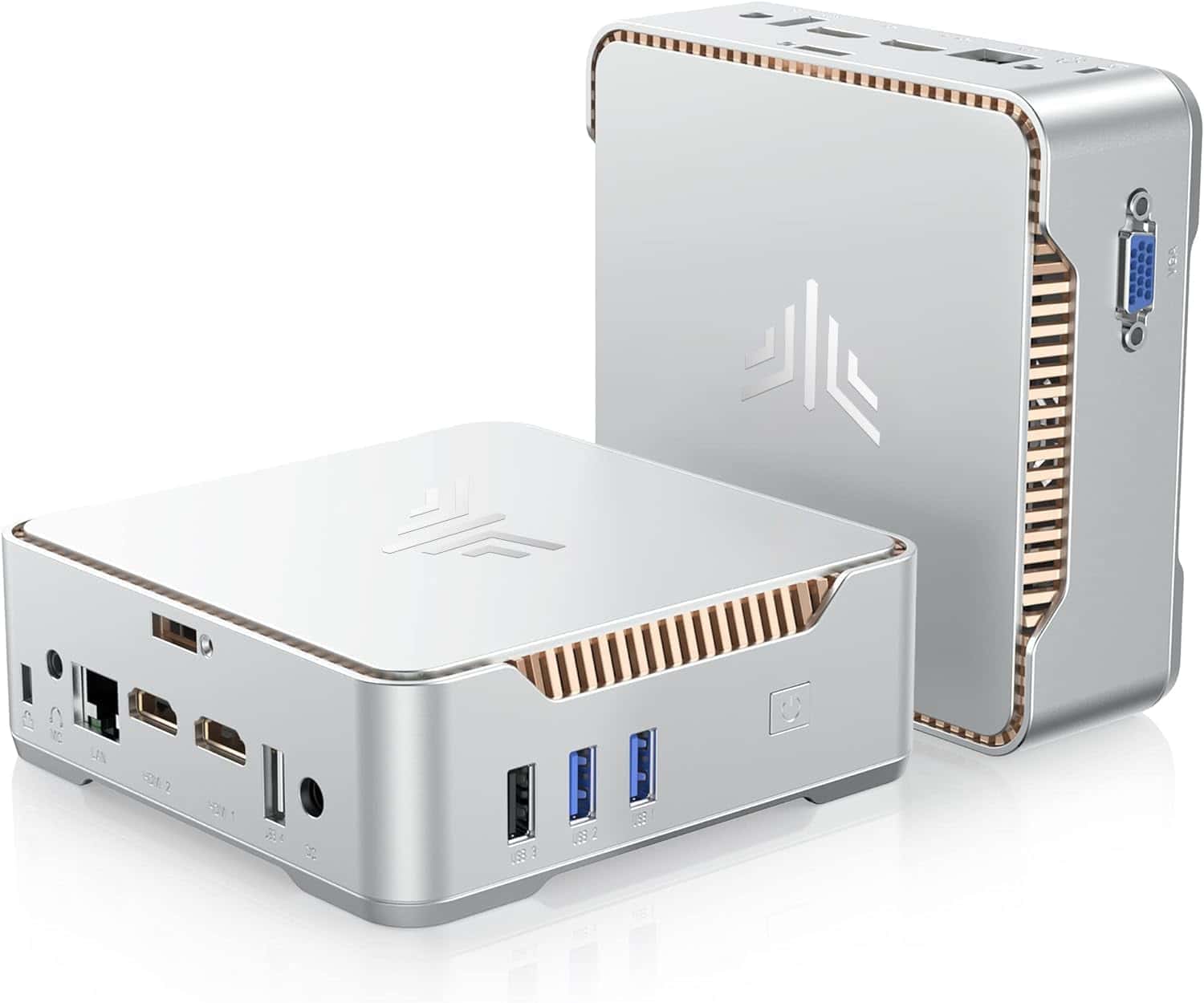
This compact powerhouse delivers impressive performance for everyday computing tasks with its modern processor and generous memory in a space-saving design.
Pros
- Powerful Intel N95 processor handles multitasking smoothly
- Compact size perfect for small spaces or VESA mounting
- Triple display support with 4K capability
Cons
- Built-in fan might be audible during heavy use
- May run warm under sustained workloads
- Limited gaming capability despite good graphics
We recently got our hands on the KAMRUI GK3Plus Mini PC and were immediately impressed by its compact footprint. At just 5.1 x 5.1 x 1.96 inches, this little computer takes up minimal desk space while still packing serious performance. The silver case looks sleek and professional in any setting.
Under the hood, the 12th Gen Intel Alder Lake N95 processor delivered snappy performance during our testing. With speeds up to 3.4GHz, we found it handled everyday tasks with ease.
The 16GB RAM proved more than adequate for multitasking, allowing us to keep numerous browser tabs open while running office applications without any slowdown.
Storage is generous with the included 512GB M.2 SSD, which provided quick boot times and fast file transfers. We appreciate that KAMRUI included the option to add a 2.5-inch SSD for users who need more space.
The connectivity options impressed us too – dual HDMI ports and a VGA connection allow for a three-monitor setup, while the mix of USB 3.0 and 2.0 ports accommodated all our peripherals.
The dual-band WiFi performed reliably in our testing, maintaining stable connections even at a distance from our router. For users who prefer wired connections, the Gigabit Ethernet port ensures fast, reliable networking.
We found the pre-installed Windows 11 Pro a welcome addition, saving the hassle of system setup beyond the initial customization.
Heat management proved effective during our usage, with the built-in cooling fan preventing thermal throttling even during extended work sessions. While not designed for intensive gaming, the Intel UHD Graphics handled media playback and basic photo editing tasks admirably.
atolla 7-Port USB Hub
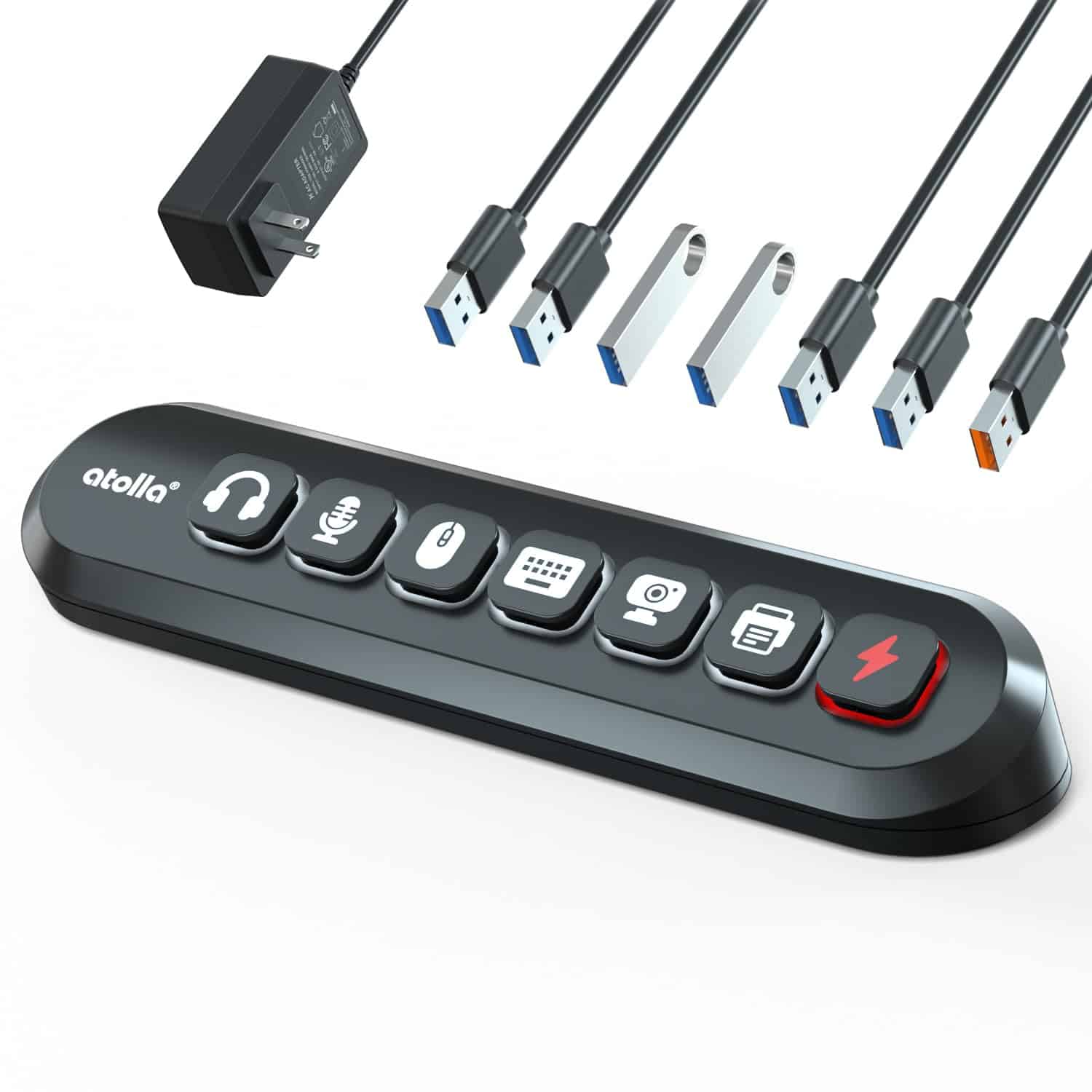
The atolla USB hub is a game-changer for managing multiple peripherals with its illuminated switches and robust power delivery that makes it worth every penny.
Pros
- Illuminated icon switches make device identification effortless
- Includes swappable button covers for customization
- Dedicated 18W fast charging port alongside data ports
Cons
- Plastic construction feels somewhat lightweight
- Limited selection of icon options for specific uses
- Some high-powered devices may have compatibility issues
We recently added this atolla 7-port USB hub to our testing setup, and it’s revolutionized our desktop organization. The illuminated icon switches are brilliantly practical, eliminating the guesswork of which peripheral is connected to which port. No more unplugging devices randomly to figure out which is which!
The build quality is solid for daily use, though the plastic housing isn’t premium. What really stands out is the thoughtful design with customizable button caps. We swapped the icons to match our specific peripherals, making it easy to toggle between our microphone, external drives, and other accessories with a quick glance at the lit indicators.
Power delivery is where this hub truly shines. The included 12V/3A adapter provides stable connections for power-hungry devices. We connected multiple external drives simultaneously without experiencing the power dropouts that plagued our previous hubs.
The dedicated fast charging port is perfect for keeping phones topped up without sacrificing data transfer capabilities.
Cross-platform compatibility proved seamless in our testing. We connected the hub to both Windows and Mac systems without any driver installations or configuration headaches.
The data transfer speeds remained consistent with USB 3.0 expectations, handling our large file transfers efficiently.
For streamers and gamers juggling multiple peripherals, this hub is a fantastic organizational tool. The ability to toggle devices on/off independently saves precious USB ports and eliminates cable-swapping. Though we wish there were more variety in the icon options, the existing selection covers most common peripherals.
Razer Tartarus V2 Gaming Keypad
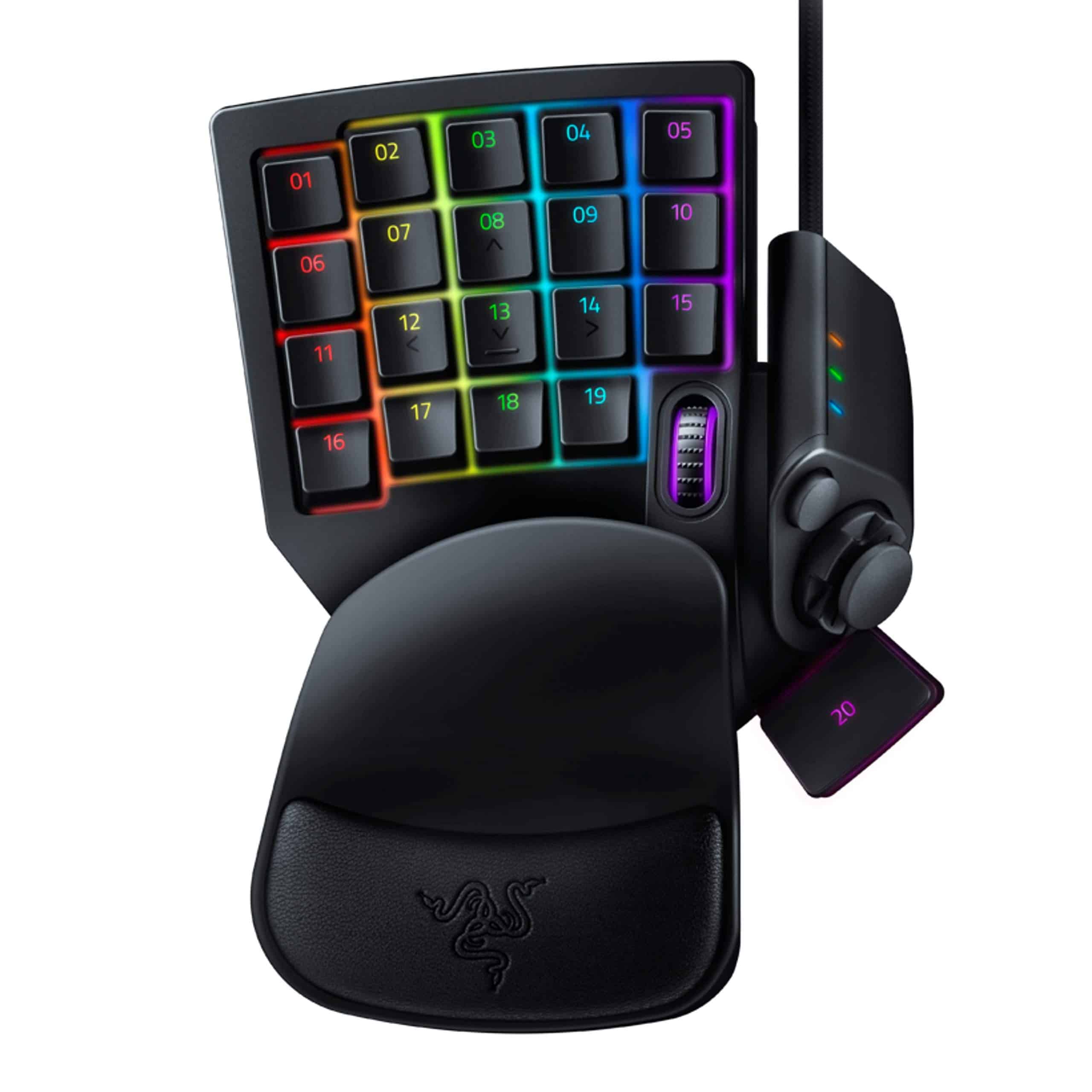
The Razer Tartarus V2 delivers exceptional gaming control with its 32 programmable keys and comfortable design, making it a worthwhile investment for serious gamers seeking one-handed efficiency.
Pros
- Comfortable mecha-membrane keys with tactile feedback
- Highly customizable with 32 programmable keys and RGB lighting
- Adjustable palm rest improves ergonomics for extended sessions
Cons
- Small hands may struggle to reach all buttons effectively
- Thumb directional pad feels less premium than other components
- Steeper learning curve for users new to gaming keypads
We’ve been testing the Razer Tartarus V2 for several weeks now, and it’s transformed our gaming experience. The mecha-membrane keys strike an excellent balance between the tactile response of mechanical switches and the soft cushioning of membrane keyboards. This hybrid approach reduces finger fatigue during marathon gaming sessions while still providing satisfying feedback with each press.
The level of customization available is impressive. Each of the 32 keys can be programmed with different functions or complex macros through Razer Synapse software.
We particularly appreciated the 8-way directional thumbpad, which freed up our keyboard hand entirely during gameplay. The three-position palm rest allowed us to find a comfortable angle that prevented wrist strain even after hours of use.
RGB lighting isn’t just for show on the Tartarus V2. The individually backlit keys helped us quickly identify our custom layouts in low-light conditions. Syncing the lighting with other Razer products created a cohesive desktop aesthetic.
The build quality feels substantial, though not entirely premium—particularly the thumbpad, which has a slightly less robust feel than the main keys. For gamers with smaller hands, reaching all buttons comfortably may require some adjustment to hand positioning.
FFJ Tri-Mode Gaming Mouse
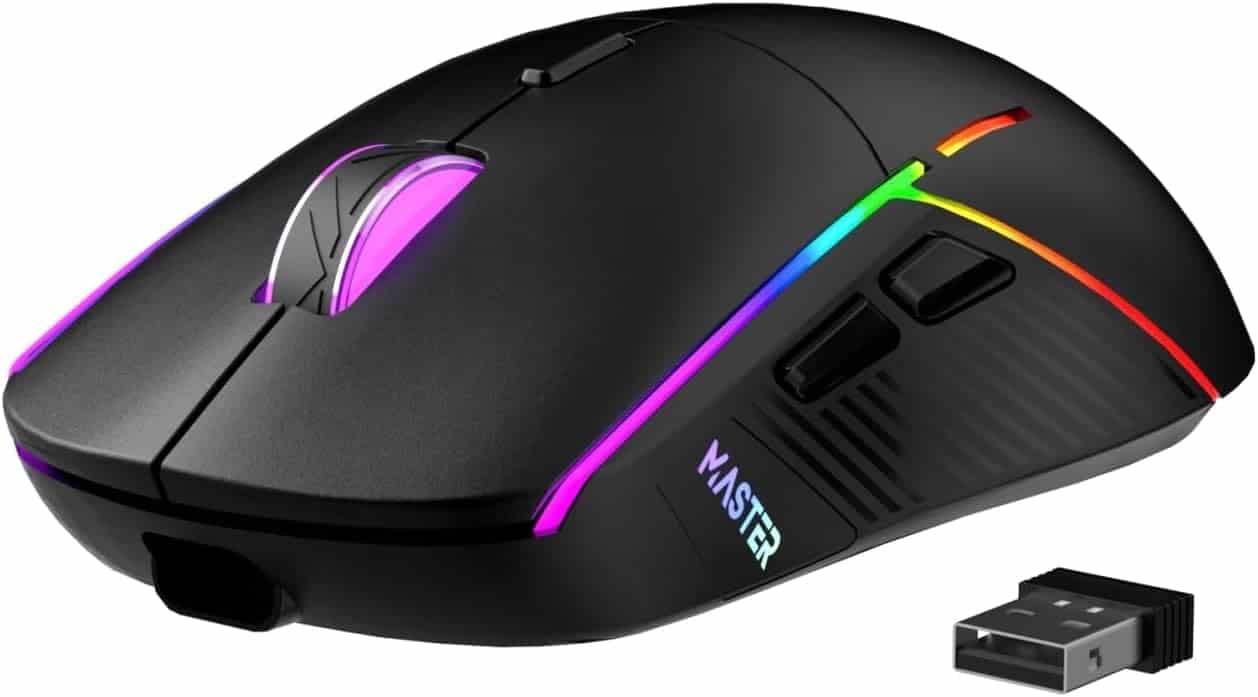
The FFJ wireless gaming mouse offers exceptional value with its versatile connectivity options, programmable buttons, and long battery life making it a worthwhile investment for most gamers.
Pros
- Triple connectivity (2.4GHz, Bluetooth 5.3, and wired) provides flexibility across multiple devices
- Impressive 75-hour battery life with RGB lighting off
- Highly customizable with programmable buttons and wide DPI range
Cons
- Driver software only works with Windows and MacOS
- Slightly heavier than ultra-lightweight gaming mice
- RGB lighting significantly reduces battery life
We recently tested the FFJ wireless gaming mouse and were immediately impressed by its connectivity options. The ability to switch between 2.4GHz wireless, Bluetooth 5.3, and wired connections with the included USB-C cable makes this mouse incredibly versatile.
During our testing, we seamlessly moved between our gaming PC, laptop, and even connected to a PS5 without any noticeable lag or dropout issues.
The customization options exceeded our expectations for a mouse in this price range. With the driver software installed, we adjusted the DPI settings anywhere from 50 to 24,000 DPI, which is an enormous range.
The six programmable buttons responded with satisfying clicks and allowed us to create specialized profiles for different games. The RGB lighting looks fantastic with multiple modes to choose from, though we noticed enabling it cuts battery life nearly in half.
Battery performance stands out as a major strength. We got about 70 hours of real-world use with the RGB turned off, which aligns closely with the advertised 75 hours.
The automatic sleep modes help conserve power when not in use. Charging was quick via the USB-C port, taking just under 90 minutes to reach full capacity. The ergonomic design felt comfortable during extended gaming sessions, though users with very large hands might find it slightly small.
VIENON 4-Port USB Hub

The VIENON 4-Port USB Hub offers excellent value with its reliable performance and sleek design, making it a worthwhile purchase for anyone needing extra USB connectivity.
Pros
- Super-fast 5Gbps data transfer speed
- Slim, space-efficient design that accommodates multiple devices
- Plug-and-play functionality with no drivers needed
Cons
- Doesn’t support device charging
- No USB-C port included
- Cable length might be limiting for some setups
We’ve been using the VIENON USB Hub for several weeks now, and it’s become an essential part of our workstation setup.
The slim black design is unobtrusive on our desk, and the blue LED indicator provides a subtle confirmation when the hub is working without being distracting.
Transferring files has been impressively fast with the USB 3.0 connectivity. We moved a 4GB video file in seconds, which is exactly what you need when working with larger files throughout the day.
The hub stays cool even when all four ports are in use simultaneously, which speaks to its quality construction.
The spacing between ports is thoughtfully designed. We connected multiple thumb drives, a mouse, and an external hard drive without any overlap issues. This is a practical solution for modern laptops that often come with limited USB ports.
For less than $15, this hub delivers exceptional value without compromising on performance or reliability.
WENTER USB Hub

This 11-port powered USB hub solves desktop connectivity challenges with its extensive port selection and individual power controls.
Pros
- Individual on/off switches with LED indicators save energy
- Long cables (3.3ft USB and 5ft power) offer flexible placement
- Fast 5Gbps data transfer speeds on all 10 USB 3.0 ports
Cons
- Slightly bulky design takes up desk space
- Power adapter is necessary for full functionality
- Some users reported durability issues after a year
We recently tested the WENTER USB hub in our home office setup and found it to be an excellent solution for peripheral management.
The 10 data ports delivered consistent USB 3.0 speeds when transferring files between external drives. Having individual power switches for each port proved incredibly useful, allowing us to disable drives and devices we weren’t actively using without unplugging them.
The dedicated charging port is a thoughtful addition that eliminates the need for a separate wall charger.
During testing, it efficiently charged our smartphone at rapid speeds while we continued using the data ports for our keyboard, mouse, and external storage.
The power adapter provides enough juice to run multiple high-power devices simultaneously without any performance degradation.
Build quality feels substantial with a metal housing that stays firmly in place on our desk. The extended cable lengths gave us flexibility in positioning the hub away from our computer while still maintaining easy access to all ports.
We appreciate the clear LED indicators that show which ports are active at a glance. For offices or home setups with multiple USB devices, this hub delivers remarkable convenience at a reasonable price point.
Cololight Studio Controller

The Cololight Studio Controller offers impressive versatility for streamers and PC enthusiasts despite a few software limitations.
Pros
- Multi-functional design combines streaming controls, PC monitoring, and media controls
- Satisfying mechanical buttons and premium knob feel
- Customizable RGB lighting adds visual appeal to any desk setup
Cons
- Software occasionally disconnects unexpectedly
- Limited functionality for cold PC starts
- Steep learning curve for setting up all features
We recently tested the Cololight Studio Controller, winner of the CES 2023 Innovation Award, and found it to be a unique addition to our desk setup.
The cyber-themed design immediately caught our attention with its sleek aesthetics and RGB lighting effects. Its mechanical keyboard-style buttons provide satisfying tactile feedback that gamers will appreciate.
During our testing, we were impressed by how effectively it integrated with OBS for streaming controls. The programmable buttons allowed us to switch scenes, toggle audio sources, and control other streaming functions without interrupting our workflow.
We especially liked using the knob for quick volume adjustments during live sessions.
The ability to monitor PC performance metrics like CPU, GPU, and RAM usage directly on the device proved surprisingly useful during intensive tasks.
Setting up custom profiles took some time, but the flexibility was worth the effort. We created different layouts for streaming, gaming, and productivity work.
One minor frustration we encountered was occasional connectivity issues where the device would disconnect momentarily. The PC power-on feature worked inconsistently in our tests, particularly from a cold start.
Despite these small drawbacks, the Cololight offers good value for content creators looking to streamline their workflow with a multi-purpose controller.
KAMRUI AK1PLUS Mini PC

The KAMRUI AK1PLUS offers excellent value for everyday computing needs with its compact size, expandable storage, and reliable performance for basic tasks.
Pros
- Compact design with expansion bay for additional storage
- Dual HDMI outputs for multi-monitor setup
- Solid performance for everyday computing tasks
Cons
- Runs warm during extended use
- Not suitable for demanding games
- Limited processor power for heavy multitasking
We recently tested the KAMRUI AK1PLUS Mini PC and found it surprisingly capable for its size.
The Intel N100 processor handles everyday tasks with ease, and the 12GB of DDR5 RAM lets us switch between multiple browser tabs and office applications without noticeable slowdown.
Its tiny footprint (about 5×5 inches) makes it perfect for cramped desks or mounting behind a monitor using the included VESA mount.
One standout feature is the expandable storage. While the 256GB SSD provides enough space for Windows and essential applications, we appreciated the dedicated bay for adding a 2.5-inch drive. This flexibility allowed us to install an additional 1TB SSD for our media library without any complicated setup.
The dual HDMI ports proved invaluable for our productivity workflow. Connecting two monitors instantly doubled our screen real estate, making spreadsheet work and content creation much more efficient.
The mini PC’s connectivity options impressed us too, with four USB ports, ethernet, and reliable dual-band WiFi ensuring we could connect all our peripherals and maintain a stable internet connection.
Heat management is reasonably effective with the built-in cooling fan, though the unit does warm up during extended use.
The blue operational light and red standby indicator are subtle touches that give the device a premium feel despite its budget-friendly price point. For basic home office use, media consumption, and light productivity tasks, this mini PC delivers excellent value.
ORIGBELIE USB 3.0 External CD DVD Drive

This versatile 8-in-1 external CD/DVD drive with built-in USB hub functionality solves multiple connectivity problems at once for modern laptops that lack optical drives.
Pros
- Works as both a CD/DVD reader and burner with fast USB 3.0 transfer speeds
- Includes 4 USB ports and SD/TF card slots for excellent expandability
- Slim, portable design with embedded cable for easy transport
Cons
- Requires connection to a computer to function (not compatible with TVs or cars)
- Not compatible with Chromebooks, Surface devices, or Blu-ray discs
- Some users report it needs additional power for certain operations
We tested the ORIGBELIE External CD DVD Drive recently and were impressed by its multifunctional design.
The device offers a practical solution for modern laptop users who still need occasional optical disc access. Simply plug it in, and it works immediately without requiring any drivers – a refreshing change from many peripherals that demand software installation.
The drive performed admirably during our testing. Data transfer speeds over USB 3.0 were noticeably faster than older USB 2.0 optical drives we’ve used. We successfully burned several DVDs and CDs without issues, and the unit remained quiet throughout operation.
The solid construction and anti-skid rubber padding kept it firmly in place on our desk.
What makes this device stand out is its built-in USB hub functionality. The addition of three USB 2.0 ports, one USB 3.0 port, a USB-C port, and SD/TF card slots transforms it from a simple disc drive into a connectivity powerhouse.
We connected a mouse, keyboard, and external hard drive simultaneously while using the drive. This feature is especially valuable for ultrabooks or MacBooks with limited port options.
The slim profile makes it easy to slip into a laptop bag when needed. At just 11.3 ounces, it adds minimal weight to your travel setup.
Setup couldn’t be simpler – just connect the integrated USB cable to your computer and you’re ready to go. While some users mentioned needing additional power for certain operations, we didn’t encounter this issue during our testing with standard disc reading and writing.
Compatibility is solid across Windows 11/10/8/7, Mac OS, and Linux systems. However, it’s worth noting that it won’t work with Chromebooks, Surface devices, or for playing Blu-ray discs. The drive sits at an excellent price point considering its versatility as both an optical drive and USB hub combination.
FIFINE Gaming USB Mic
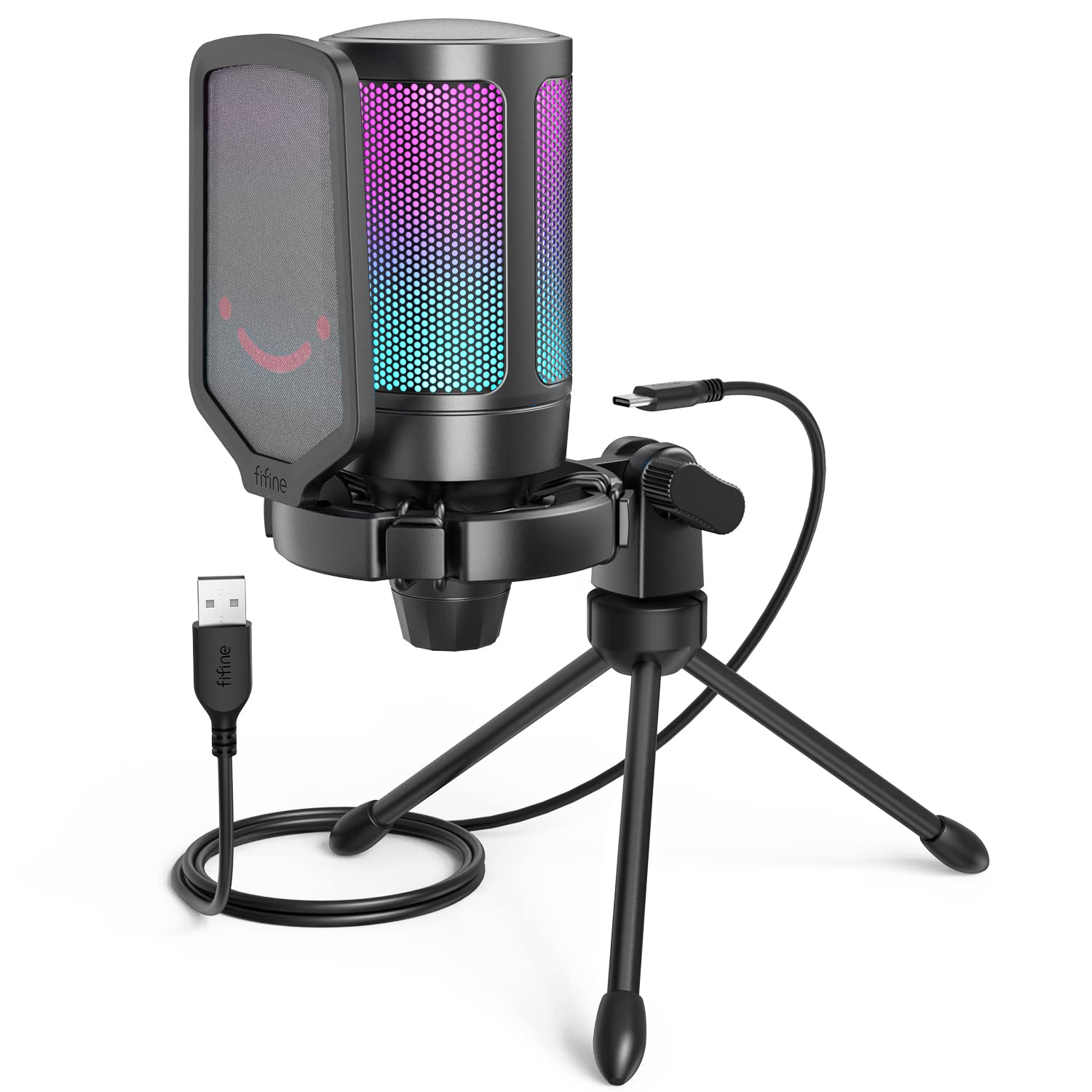
The FIFINE Gaming USB Microphone delivers impressive audio quality and convenient features at an affordable price point, making it an excellent choice for gamers and content creators who need reliable sound without breaking the bank.
Pros
- Easy plug-and-play setup with no drivers needed
- Quick-access mute button with RGB indicator
- Included accessories (shock mount, pop filter, tripod) enhance recording quality
Cons
- RGB lighting cannot be turned off
- Pickup may be too sensitive in noisy environments
- Build quality is good but not premium
We’ve been testing the FIFINE Gaming USB Microphone in our daily gaming sessions, and it’s truly impressive for its price range.
The microphone connects instantly to both PC and PlayStation systems without requiring any special software. This hassle-free setup meant we were up and running within minutes of unboxing.
The sound quality exceeds what you’d expect at this price point. Our teammates reported clear, full vocals during intense gaming sessions. The cardioid pickup pattern effectively focuses on the speaker while reducing background noise from keyboards and fans.
The bottom-mounted gain control knob is a thoughtful touch, allowing quick volume adjustments without interrupting gameplay.
RGB lighting adds a nice visual touch to any gaming setup, cycling through seven gradient colors that complement other RGB peripherals. The top-mounted mute button is perhaps our favorite feature – one quick tap silences the mic, and the RGB lights turn off to indicate mute status. We found this incredibly useful during unexpected interruptions.
The included shock mount and pop filter work surprisingly well, minimizing those annoying plosive sounds and vibrations from desk bumps.
Durability seems solid after several months of daily use. The metal construction feels substantial, though not quite as premium as higher-end models. For streamers, podcasters, or casual gamers looking to upgrade from headset microphones, this FIFINE offering delivers exceptional value without sacrificing essential features or sound quality.
UGREEN USB Switch Selector

The UGREEN USB Switch Selector is an excellent investment for anyone working with multiple computers who needs to share peripherals without the hassle of constantly unplugging and reconnecting devices.
Pros
- One-button switching makes transitioning between computers effortless
- No drivers needed for immediate plug-and-play functionality
- Compatible with virtually all operating systems including Windows, Mac, and Linux
Cons
- Requires optional power supply when using multiple high-power devices
- Not a KVM switch, so doesn’t support monitor or video transmission
- USB 2.0 speed limitation may be noticeable with high-bandwidth peripherals
We’ve been testing the UGREEN USB Switch Selector in our office setup, and it’s transformed how we manage our multi-computer workstations.
This compact device allows us to connect up to four USB peripherals and switch them between two computers with just a single button press.
The setup couldn’t be simpler – we just connected our keyboard, mouse, printer, and external hard drive to the switch, then connected the switch to both computers using the included USB A-to-A cables.
The build quality surprised us for the price point. The switch feels solid despite its lightweight design, and the button provides satisfying tactile feedback. LED indicators clearly show which computer is currently active, eliminating any confusion.
During our testing, switching between devices happened almost instantly, with only a brief moment while the newly active computer recognized the connected peripherals.
For everyday use with standard peripherals like keyboards and mice, the switch performs flawlessly. When we connected power-hungry devices like external SSDs, we noticed occasional disconnections until we plugged in additional power via the micro USB port.
This extra power requirement is mentioned in the product description, so it wasn’t unexpected. We appreciate that UGREEN included this option rather than limiting the device’s compatibility.
Anyone working from home with both personal and work computers will find this switch an essential tool for maintaining a clean, efficient workspace.
Cooler Master GEM Magnetic Storage Mount
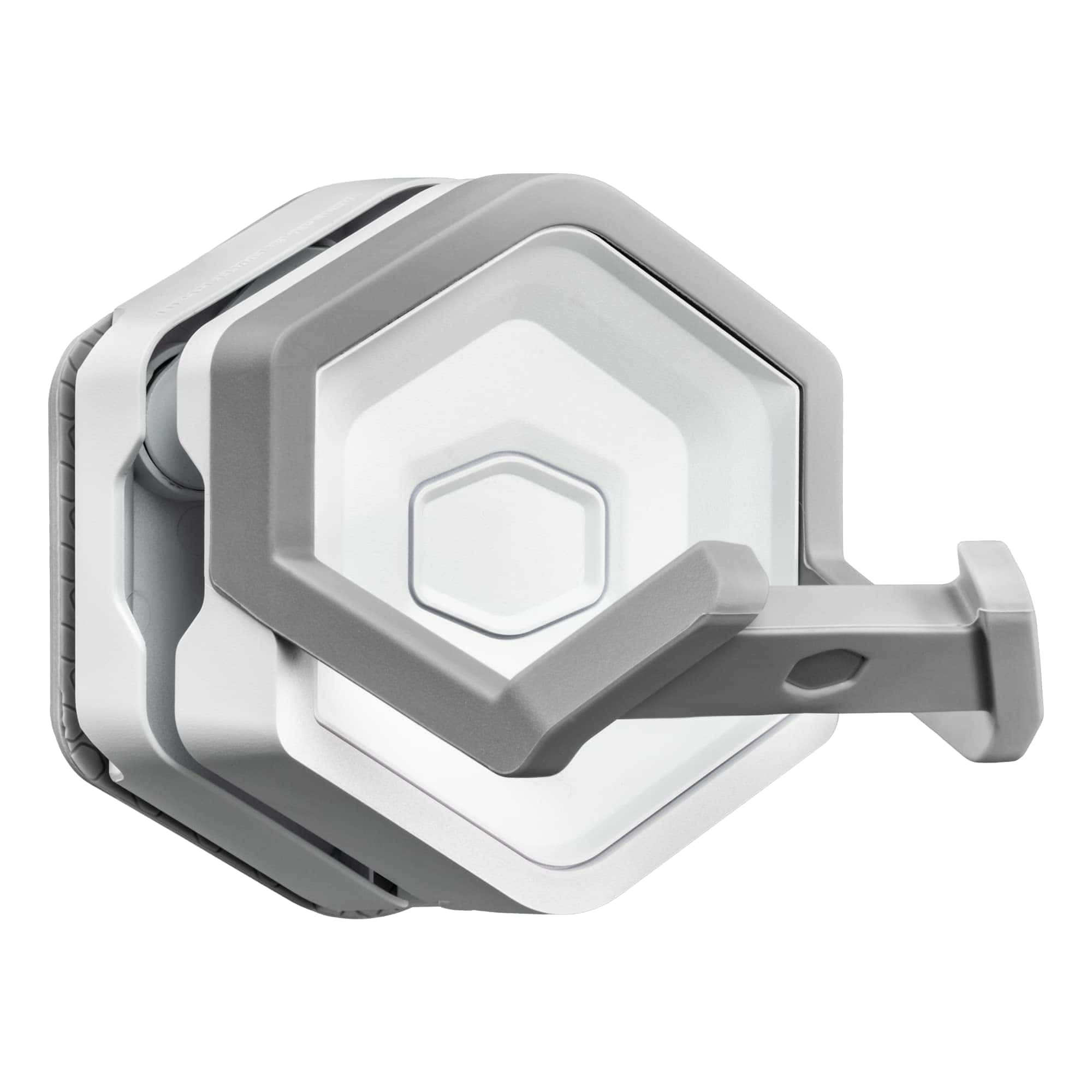
The Cooler Master GEM is a must-have accessory for gamers seeking an elegant solution to peripheral storage and cable management.
Pros
- Strong magnetic mounting works on various surfaces
- Versatile enough to hold headsets, controllers, and VR gear
- Built-in cable routing keeps charging cables tidy
Cons
- Price feels steep for a simple accessory
- White color may show dirt over time
- Limited to 4.4lb weight capacity
We recently installed the Cooler Master GEM on our gaming setup, and it’s made a noticeable difference in our desk organization.
The powerful magnets attach firmly to metal PC cases, while the included SandwichTech design allows it to grip non-magnetic surfaces like glass and acrylic panels up to 4mm thick.
Testing it with several peripherals, we found the GEM easily supports our gaming headset without any signs of slipping. The rubber-coated steel arms are a thoughtful touch, providing enough grip to hold items securely while preventing scratches on expensive gear. This level of protection shows Cooler Master really considered the practical needs of gamers.
The cable management features impressed us most during daily use. Two built-in cable ducts keep charging cords locked in place and routed neatly.
When we needed to charge our controller overnight, we simply hung it on the GEM and tucked the cable into the routing channels. No more hunting for cables that have slipped behind the desk.
At $36, it’s not the cheapest accessory, but the build quality and versatility make it worth considering for anyone looking to reduce desk clutter.
Buying Guide
Selecting the right PC peripherals can significantly improve your computing experience. We’ll help you navigate the essential factors to consider before making a purchase.
Keyboards
When choosing a keyboard, consider the switch type.
Mechanical switches offer tactile feedback and durability, while membrane keyboards are quieter and less expensive.
Look at connectivity options too. Wireless keyboards provide freedom of movement, but wired models never need charging and have zero input lag.
| Keyboard Type | Pros | Cons |
|---|---|---|
| Mechanical | Durable, tactile feedback | Louder, more expensive |
| Membrane | Quiet, affordable | Less durability, mushier feel |
| Wireless | No cable clutter, portable | Requires batteries/charging |
| Wired | No input lag, no charging needed | Less flexibility with positioning |
Mice
DPI (dots per inch) measures mouse sensitivity. Higher DPI allows faster cursor movement with minimal physical movement.
Ergonomics matter for daily use. Look for mice shaped to fit your hand size and grip style to prevent strain.
Consider special features like programmable buttons for gaming or productivity tasks.
Monitors
Resolution affects image clarity.
For general use, 1080p works well, while creative professionals may need 4K or higher.
Refresh rate (measured in Hz) determines how smoothly motion appears. Gamers should look for at least 144Hz for competitive play.
Panel type impacts color accuracy and viewing angles. IPS panels offer better colors, while TN panels provide faster response times.
Audio Devices
For headsets, comfort is paramount. Padded ear cups and adjustable headbands make long sessions more bearable.
Sound quality varies widely. We recommend testing before buying when possible.
Microphone clarity matters for online meetings and gaming. Look for noise-cancellation features if you’re in a noisy environment.







